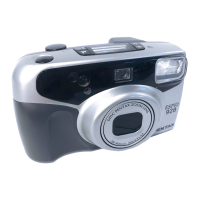36
FOCUS-LOCK SHOOTING
,>- Ji
If
you s
hoot
with
out positi oning the a
uto
focus
fr
am
e «
(J
) on th e main
subj
ect of th e illu
str
a-
tion as shown
abo
vc, only the ba c
kgrou
nd will
he in focus.
Wh
en th e main suh
jc
ct is off the
au tofocus fr
ame
in the center of th e
view
linder ,
use the focus-Jock te
chn
iqu e.
(Focus lock is the Iunct ion to Jock Iocus.)
'
......
..,,
,.-.,
'~
.
[
J
Focus on th e suh
je
ct
with
the autofocus frame
«(J). .
Wh
en you wish to focu s on the face, which
appca rs
very
sma ll in th e vicwfinde r, focus on
Note:
the chest instead to fill th e focus fr
ame
with
• You can release focus lock simply by liftin g
mor e or the s
ub
jcct .
your finger from th e shuu er release
butten
.
2
Wh
en th e
shu
tte
r releas e burt on is d
epr
essed
halfway down , the grec n l
arnp
on the lefr-
h
and
side of the viewfin
de
r li
ght
s up and th e
exposu
re and f
ocu
s are tem poraril y lockcd ,
3
Whil
e d
epr
essmg th e
shutt
er release b
urton
halfw ay, rc
-aim
th e ca mera or rec
om
pose the
pi
ctur
e, th en rclc ase the shutrer.
Hard
-to
-autofocus
subj
ects
Like
ma
ny e ther
aut
of
ocus came ras, th e
camcra 's auto focus syste m is hi
ghly
pre-
cise, but nut pe
rf
ecto Sorne subj ects
may
not be focused as you wish. In suc h a case,
use the focus-lock te
chn
iqu e on a subject
near th e
act
ua l one
and
eq uidistant
fram
the lens. Subjects
wh
ieh may fool th e
syste m incl udc :
1. Black ob
jcc
ts like
hair,
whi ch don
't
re-
Ilcct rnu ch li
ght
(a
nd thereforc d
on't
reflect
inf
ra red autofocus beam s) ,
2.
Wir
c n
ell
ing, la u icc
wor
k, ira n exercisc -
bars, etc .
3. Fliekering li
ght
sources such as neon
signs, fluoresc
ent
l
amps
, TV images, sun-
light com ing
through
tr ees, etc. and sub-
jecis illuminated by th esc light sou rces.
4. Glossy and reflccrive surfaces lik e glass,
m
irr
ors, ca r bod ies, etc .
5. Fast-rnoving ob
jc
cts, likc trains or a
ut
o-
m
obi
les in
moti
on.
6. Wat cr jet s, wal er surface, srno kc, flarne,
. firew
ork
s, eic., whi ch have no dis tinct or
consistent form, or a suhjec t in rnist.
37

